The woolly-necked stork has been split into two species:
- Asian woolly-necked stork, Ciconia episcopus
- African woolly-necked stork, Ciconia microscelis
The woolly-necked stork has been split into two species:
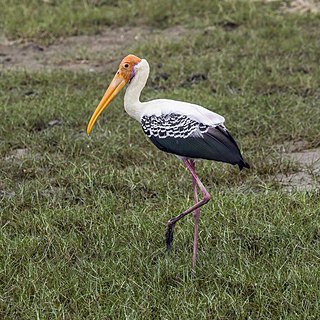
Storks are large, long-legged, long-necked wading birds with long, stout bills. They belong to the family called Ciconiidae, and make up the order Ciconiiformes. Ciconiiformes previously included a number of other families, such as herons and ibises, but those families have been moved to other orders.
The white stork is a large bird in the stork family, Ciconiidae. Its plumage is mainly white, with black on the bird's wings. Adults have long red legs and long pointed red beaks, and measure on average 100–115 cm (39–45 in) from beak tip to end of tail, with a 155–215 cm (61–85 in) wingspan. The two subspecies, which differ slightly in size, breed in Europe, northwestern Africa, southwestern Asia and southern Africa. The white stork is a long-distance migrant, wintering in Africa from tropical Sub-Saharan Africa to as far south as South Africa, or on the Indian subcontinent. When migrating between Europe and Africa, it avoids crossing the Mediterranean Sea and detours via the Levant in the east or the Strait of Gibraltar in the west, because the air thermals on which it depends for soaring do not form over water.
The black stork is a large bird in the stork family Ciconiidae. It was first described by Carl Linnaeus in the 10th edition of his Systema Naturae. Measuring on average 95 to 100 cm from beak tip to end of tail with a 145-to-155 cm (57-to-61 in) wingspan, the adult black stork has mainly black plumage, with white underparts, long red legs and a long pointed red beak. A widespread but uncommon species, it breeds in scattered locations across Europe, and east across the Palearctic to the Pacific Ocean. It is a long-distance migrant, with European populations wintering in tropical Sub-Saharan Africa, and Asian populations in the Indian subcontinent. When migrating between Europe and Africa, it avoids crossing the Mediterranean Sea and detours via the Levant in the east or the Strait of Gibraltar in the west. An isolated, non-migratory, population occurs in Southern Africa.

The marabou stork is a large wading bird in the stork family Ciconiidae native to sub-Saharan Africa. It breeds in both wet and arid habitats, often near human habitation, especially landfill sites. It is sometimes called the "undertaker bird" due to its shape from behind: cloak-like wings and back, skinny white legs, and sometimes a large white mass of "hair".
The Asian woolly-necked stork or Asian woollyneck is a species of large wading bird in the stork family Ciconiidae. It breeds singly, or in small loose colonies. It is distributed in a wide variety of habitats including marshes in forests, agricultural areas, and freshwater wetlands across Asia.
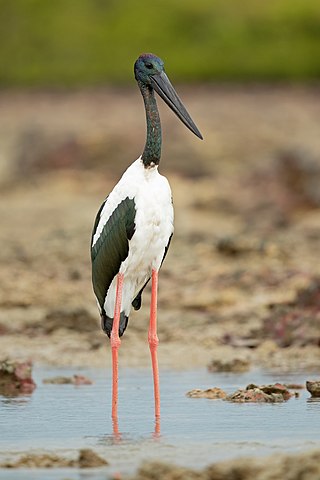
The black-necked stork is a tall long-necked wading bird in the stork family. It is a resident species across the Indian Subcontinent and Southeast Asia with a disjunct population in Australia. It lives in wetland habitats and near fields of certain crops such as rice and wheat where it forages for a wide range of animal prey. Adult birds of both sexes have a heavy bill and are patterned in white and irridescent blacks, but the sexes differ in the colour of the iris with females sporting yellow irises and males having dark-coloured irises. In Australia, it is sometimes called a jabiru although that name refers to a stork species found in the Americas. It is one of the few storks that are strongly territorial when feeding and breeding.

Ciconia is a genus of birds in the stork family. Six of the seven living species occur in the Old World, but the maguari stork has a South American range. In addition, fossils suggest that Ciconia storks were somewhat more common in the tropical Americas in prehistoric times.
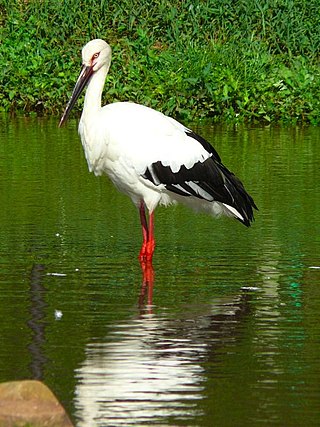
The Oriental stork is a large, white bird with black wing feathers in the stork family Ciconiidae.
Abdim's stork, also known as the white-bellied stork, is a stork belonging to the family Ciconiidae. It is the smallest species of stork, feeds mostly on insects, and is found widely in open habitats in Sub-Saharan Africa and in Yemen. The common name commemorates the Turkish Governor of Wadi Halfa in Sudan, Bey El-Arnaut Abdim (1780–1827).
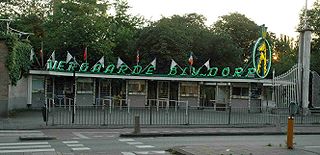
Diergaarde Blijdorp, officially Rotterdam Zoo, is a zoo located in the northwestern part of Rotterdam. It is one of the oldest zoos in the Netherlands, and has been operated by the Stichting Koninklijke Rotterdamse Diergaarde. Divided into several zoogeographic regions, the 26-hectare (64.25-acre) Blijdorp Zoo boasts well over 180 species. It also has a shop, multiple cafes, and an information centre.

Storm's stork is a medium-sized stork species that occurs primarily in lowland tropical forests of Indonesia, Malaysia and southern Thailand. It is considered to be the rarest of all storks, and is estimated to number less than 500 wild individuals throughout its geographic range. The population has long been in decline and the primary cause is widely considered to be deforestation of its native habitat.
The maguari stork is a large species of stork that inhabits seasonal wetlands over much of South America, and is very similar in appearance to the white stork; albeit slightly larger. It is the only species of its genus to occur in the New World and is one of the only three New World stork species, together with the wood stork and the jabiru.

The dusky eagle-owl is an owl species in the family Strigidae that is widespread in South and Southeast Asia. The type specimen used to describe the species was collected on the Coromandel Coast, which was used for the specific epithet. It is listed as Least Concern on the IUCN Red List. The species's extent of occurrence is estimated at 9,250,000 km2 (3,570,000 sq mi). However, volunteer generated databases such as eBird.org suggest that the available extent of occurrence is a vast over-estimate.

Indawgyi Lake Wildlife Sanctuary is a biosphere reserve in Myanmar, covering 814.99 km2 (314.67 sq mi). It ranges in elevation from 105–1,400 m (344–4,593 ft) encompassing the surroundings of Indawgyi Lake in Mohnyin Township, Kachin State. It was gazetted in 2004, is recognized as an Important Bird Area and as one of the ASEAN Heritage Parks. An area of 478.84 km2 (184.88 sq mi) comprising the lake and the surrounding lowland is a Ramsar site since February 2016.
Ciconia maltha, also known as the asphalt stork or La Brea stork, is an extinct stork from the Late Pliocene – Late Pleistocene of United States, Cuba and Bolivia. It has been found in the La Brea Tar Pits.

The Jagdishpur Reservoir is a reservoir in Jahadi Village Development Committee, Kapilvastu District, Nepal which was named after Er. Jagadish Jha who designed and supervised the construction of Banaganga dam. With a surface area of 225 ha (2.25 km2), it is the largest reservoir in the country and an important wetland site. It is situated at an altitude of 197 m (646 ft). The maximum water depth varies between 2 m (6.6 ft) in the dry season and 7 m (23 ft) in the monsoon season.
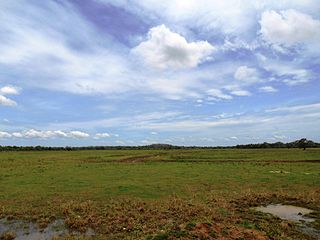
Somawathiya National Park is one of the four national parks designated under the Mahaweli River development project. Somawathiya Chaitya, a stupa said to be containing a relic of the tooth of the Buddha, is situated within the park. The park was created on 2 September 1986, having been originally designated a wildlife sanctuary on 9 August 1966. The park is home to many megaherbivores. The national park is located 266 kilometres (165 mi) north-east of Colombo.

De Alde Feanen National Park is a national park in the Netherlands province of Friesland. The Alde Feanen is also a Natura 2000 area.

Black Stork in a Landscape is an 18th-century watercolor painting of a woolly-necked stork. The painting, which is currently in the collection the Metropolitan Museum of Art, was commissioned by Claude Martin as part of a series of 658 ornithological paintings.
The African woolly-necked stork or African woollyneck is a species of large wading bird in the stork family Ciconiidae. It breeds singly, or in small loose colonies. It is distributed in a wide variety of habitats including marshes in forests, agricultural areas, and freshwater wetlands across Africa.